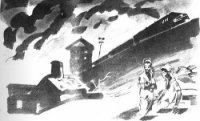Operation Nemesis: The Assassination Plot that Avenged the Armenian Genocide - Bogosian Eric (мир книг .txt) 📗
By the fall of 1919, it had become clear that the postwar punishments against the Ittihad could never be fully implemented. Most of those who had organized or prosecuted the annihilation of the Armenian population had either evaded arrest altogether or been granted their freedom in exchange for the release of British prisoners kidnapped in the east by Kemal’s nationalists. To make matters worse, the few executions of war criminals that did take place were immediately met with an enormous negative backlash from the Muslim population. Former CUP members were emboldened to speak out against the British occupation and fire up the popular resistance.
The nationalist Turks under Kemal were winning the war of attrition against the Allied occupiers. The British were essentially on their own; the Americans could not establish a mandate, a protectorate, or anything like it. Russia would no longer support the Armenians in the east while the Turkish National Movement’s General Kazim Karabekir had Yerevan surrounded. Medz Yeghern—the Great Crime—was going unpunished, unanswered, even as massive numbers of refugees continued to perish on the outskirts of and within the Republic of Armenia.
Certain prominent ARF members demanded that action be taken to “clear the debt.” Assassination was one answer, but the ARF “Bureau,” as the official Tashnag leadership was known, were not enthusiastic about such a scheme. Armen Garo, of Bank Ottoman fame, now the special ambassador for the new Armenian Republic, and his fellow Bureau member Shahan Natali were persistent, and presented the plan before the Armenian Revolutionary Federation’s Ninth General Congress in Yerevan in September–October 1919. A heated debate arose concerning reprisals. Many were not so keen on violent retribution, believing that the best revenge would be to strengthen the young nation and find an answer to the massive influx of refugees there. Vast numbers of starving, diseased refugees were crowding into the tiny state, which had neither enough food nor adequate health facilities for them. Even as the Armenian soldiers continued to fight, thousands died in the streets, victims of rampaging typhus and desperate food shortages. In what remained of the deportation camps in Syria, a parallel universe of illness and starvation was destroying what was left of the survivors there. Indeed, many saw the very survival of the Armenian people as itself a kind of revenge. For these Armenian nationalists, preserving the beleaguered nation was the first and only concern. Nonetheless, Garo and Natali prevailed upon the General Congress to approve a secret resolution titled the “Special Mission” (Hadug Kordz). Garo would be the executive in charge.
The first step in the creation of “Operation Nemesis” was the compilation of a list of the former Ittihadists and Ottoman leaders responsible for the deportations and massacres. In fact, lists had already been compiled for the tribunals in Constantinople; these lists were reviewed and became prioritized for the meting out of lethal punishment. The men on the final list would become the targets of specially assembled assassination squads. The actual lists are buried in Tashnag archives, but some are said to be as long as two hundred names. They would include Enver Pasha, Mustapha Kemal Pasha, and Djemal Pasha; notorious governors like Cevdet Bey (Van), Muamar Bey (Sivas), and Djemal Azmi Bey (Trebizond); police chiefs Bedri Bey and Azmi Bey; ruthless commanders like Topal Atif and Kara Kemal; and leaders of the Special Organization, Dr. Behaeddin Shakir and Dr. Mehmet Nazim. At the top of the list was Talat Pasha, minister of the interior and finance and, during the last months of the war, Grand Vizier. For the Nemesis conspirators, Talat would be known as “Number One.”11
The highest level of secrecy was maintained, while almost a year went by as the logistics were ironed out. Operation Nemesis was christened on July 8, 1920, in Boston, at the twenty-seventh regional conference of the Armenian Revolutionary Federation.12 It would operate out of Watertown, Massachusetts, with Shahan Natali (Hagop Der Hagopian), former editor of Hairenik newspaper, as operational coordinator. Natali had become an American citizen in 1915 and was living in Watertown under an assumed name, “John Mahy.” CPA Aaron Sachaklian, a man Armen Garo trusted totally, then residing in Syracuse, New York, would act as bursar and logistical leader. Later, General Sebouh (Arshag Nersesian) would immigrate to the United States to replace the ailing Garo. A protege of General Antranig, Sebouh had seen almost twenty years of continuous fighting and had been Tehlirian’s commanding officer in northern Persia. The assassination team’s efforts would be financed by the Hadug Kumar, or “Special Fund,” which in turn would be fed by a stream of donations from wealthy (mostly American) Armenians who may or may not have suspected where their donations were going. The teams of “avengers” volunteering to “service the debt” were called the Hadug Marmin, or “Special Corps.” There would be no shortage of volunteers.
Tehlirian, having decided on his own to find and kill Talat, was ignorant of the ARF’s decision to sanction this plot to avenge the genocide. For months he had knocked around Constantinople, seeking sponsorship for his own one-man crusade. He had even approached the Armenian patriarch Zaven Der Yeghiayan, seeking funds to underwrite his mission of revenge. The former leader of the Armenian millet in Constantinople, like the entire Armenian community, was aware that this youthful soldier had gunned down Megerdichian. Zaven blessed the young man but, as a man of the cloth, would not help Tehlirian.
Hiding out in Constantinople, Tehlirian became distraught. His mother haunted him in his dreams. He saw himself as having little worth, as he had not been able to avenge his family’s murder. Frustrated that he could not find a sponsor, and in the hopes of running into Danielian, Tehlirian moved to Paris in November 1919. He had received a postcard from her inscribed with a poem. He believed he was being sent a cryptic message and that he would soon be called to action.
Tehlirian arrived in Paris restless and adrift, annoyed by the hustle and bustle of the big city. The streams of speeding automobiles reminded him of flocks of crows. Unsuccessful in locating Danielian, he dropped in on Avedis Aharonian, the Armenian diplomat in Paris who was lobbying on behalf of Armenia in the peace talks. Tehlirian was received politely but then quickly shown the door. Aharonian could not jeopardize his position by being linked directly to a man who might be an assassin. His primary concern, as Turkish troops moved closer and closer to Yerevan, was survival of his fledgling republic.
Tehlirian bided his time in the French capital, finding work as a cobbler. As the months dragged on, his obsession with Talat grew, as had his obsession with Megerdichian. While he mended shoes, he fantasized about the various ways he might kill the ex-leader, revisiting the problem over and over in his mind, breaking it down into steps. The first step was obvious: to find the man hiding somewhere in Europe. This would require funds as well as the proper passports and visas to travel freely. He would need access to the kind of privileged information to which only government agencies were privy. He would need a weapon. Where could he obtain a pistol? What sort of pistol would be most effective? And, assuming he found him, what if the burly Talat somehow fought back? Or what if Talat were surrounded by bodyguards? Would Soghomon lose his nerve? Would he be willing to die in his effort? And what if he succeeded? How would he escape? What if he couldn’t escape? Could he face execution? It would be worth it. He pictured Talat’s face as “the monster” died. The fantasy sustained the nervous young man.




